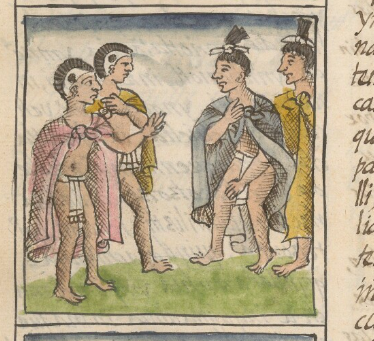temillotl (FCbk4v71v)
This is an iconographic example of the warrior hairstyle called the temillotl. The scene shows two men in a ¾ view (but with their heads in profile), facing toward the left. In the contextualizing image, one can see that they are meeting two other men with a different hairstyle. The men with the temillotl style have their black hair tied up with white (cloth?) ties so that it stands up like a column or pillar atop their heads. Their clothing consists of a loincloth and a cape; one has a yellow cape and one has a blue cape. They are barefooted, standing on grass. This grounding shows European stylistic influence, as does the shading that gives three-dimensionality.
Stephanie Wood
The term temillotl does not come from the text at this place in the manuscript (Digital Florentine Codex), but it is identified by the keywording team. The name Temillo was a popular one with Nahua men in the sixteenth century. It seems to derive from the distinguished warrior who got to wear this particular hairstyle after taking at least four captives in war. Below are some of the various ways glyphs were drawn with a desire to elicit the name Temillo (also spelled Temilo, some of the time). In some cases, the ponytail stands straight up like a pillar, and in some cases it bends over. One of the attestations below shows the base of a stone column, which was a completely different way of showing Temillo, but Alfonso Lacadena (2018, 85) has also suggested that this one involves the use of a round stone column (temimilolli) as an approximation of temillotl.
Stephanie Wood
1577
Jeff Haskett-Wood
piedra, peinado, cabello, pelos, guerreros, guerra, cautivos, tilmatli
temillo(tl), a warrior hairstyle, https://nahuatl.wired-humanities.org/content/temillotl
un peinado de guerreros
Stephanie Wood
Available at Digital Florentine Codex/Códice Florentino Digital, edited by Kim N. Richter and Alicia Maria Houtrouw, "Book 4: The Soothsayers", fol. 71v, Getty Research Institute, 2023. https://florentinecodex.getty.edu/en/book/4/folio/71v/images/c272547c-06... Accessed 27 June 2025.
Images of the digitized Florentine Codex are made available under the following Creative Commons license: CC BY-NC-ND (Attribution-NonCommercial-NoDerivs 4.0 International). For print-publication quality photos, please contact the Biblioteca Medicea Laurenziana ([email protected]). The Library of Congress has also published this manuscript, using the images of the World Digital Library copy. “The Library of Congress is unaware of any copyright or other restrictions in the World Digital Library Collection. Absent any such restrictions, these materials are free to use and reuse.”








